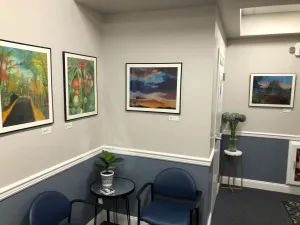Providing Maps of Virus Proteins for the World’s Scientific Community
 Professor Brian Olson, of the Department of Biology and Chemistry at County College of Morris (CCM), recently had his research on coronavirus targets published in the peer-reviewed Journal of Computer-Aided Molecular Design to assist with the development of drugs to combat the virus.
Professor Brian Olson, of the Department of Biology and Chemistry at County College of Morris (CCM), recently had his research on coronavirus targets published in the peer-reviewed Journal of Computer-Aided Molecular Design to assist with the development of drugs to combat the virus.
Olson, the lead author on the paper, worked with Dr. Tom Kurtzman of Lehman College to put together a team of researchers this past March when he realized how extensive the COVID-19 pandemic would become. In the paper, An Online Repository of Solvation Thermodynamic and Structural Maps of SARS-CoV-2 Targets, the researchers provide maps of water molecules on the virus’ proteins that also are known as solvation maps. Olson explains that knowing which water molecules need to be displaced, and which do not, provides essential information to guide the development of drugs to treat COVID-19. The first step toward determining that is mapping where the water molecules are located on the proteins.
In March, Olson, who had been tracking the coronavirus on several databases, was certain COVID-19 would turn into a pandemic.
“We were seeing clusters on multiple continents and were unable to trace the sources of infection. It was clear this was going to be an immediate and international public health issue,” he says. “That compelled me to do something.”

An image of one of the maps of water molecules, in red and white, on a coronavirus protein.
Utilizing the computational tool, GIST, developed by Kurtzman, the researchers worked from their homes during the pandemic. Prior to being published in the Journal of Computer-Aided Molecular Design, the research was posted by the team on Chemrxiv so it could be accessed early while the peer-review process was taking place.
Now that solvation maps of the COVID-19 virus are available, Olson and his team plan to use that information to search for new drugs. Making the information public and free also will aid others in their search for new and effective pharmaceuticals to defeat the coronavirus. According to Altmetric’s Attention Score, which measures the online attention and activity of research papers, the work conducted by the Olson team ranks in the top 25 percent. Given that ranking, based on more than 2,200 views and over 300 downloads of the paper, Olson is encouraged about the development of drugs to fight the coronavirus.
“I have never seen the international scientific community come together the way it has now to find some answers,” says Olson. “There is international collaboration and the sharing of information that previously would not have been shared.”
Olson, who teaches forensic science at CCM, joined the college’s faculty in 2018. At CCM, he and several other professors, developed the college’s first virtual reality class to teach students forensic science skills by analyzing murder scenes. Along with his work on the coronavirus, he is researching the development of pain killers to replace opiates.
Olson earned his associate degree in science from the Borough of Manhattan Community College, his bachelor’s in biochemistry from Hunter College, his master’s in biochemistry from the City University of New York (CUNY) Graduate Center, and is working on his doctorate in biochemistry from CUNY Graduate Center.
He is a strong advocate for community colleges, and CCM in particular. “Community colleges place a high value on quality teaching,” he says. “I am so fortunate. I have fun researching tiny molecules and on top of that I get paid to talk to students about narcotics, murders and other fascinating topics. I can’t imagine having a better job.”



